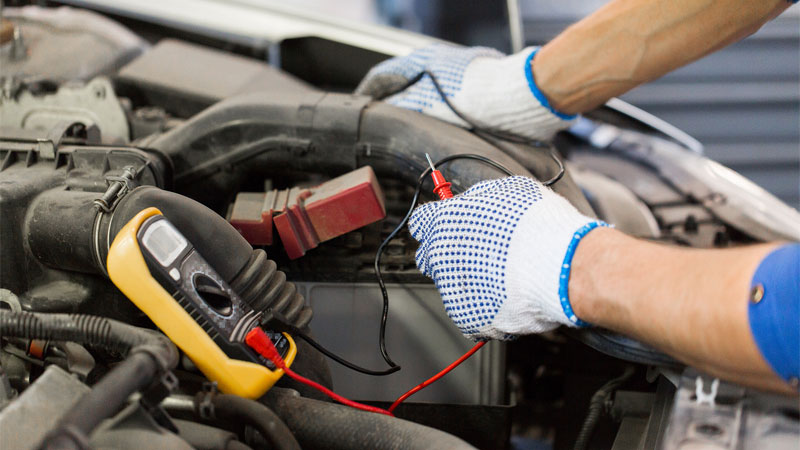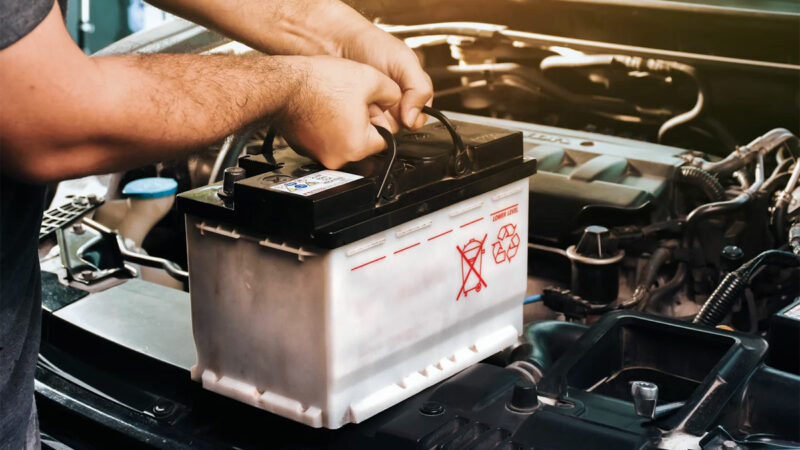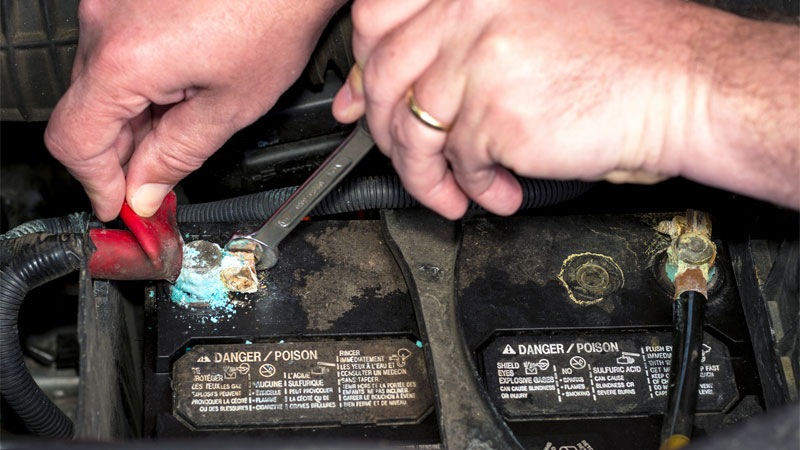It’s a frosty morning, and you’re already running late for work. You turn the key in your car’s ignition or push the Start button, but instead of the engine roaring to life, you’re met with a demoralizing silence.
Sound familiar? Cold weather can wreak havoc on your car’s ability to start, leaving you stranded and frustrated. Let’s look at the common causes behind cold-weather starting issues and tell you what you can do to prevent this from happening in the future.
Common Causes of Cold Weather Starting Issues
1. Battery Problems
A car battery is the most common culprit behind cold weather starting issues. As the temperature drops, the battery’s capacity decreases, making it harder for it to provide the necessary current to start the engine.
Over time, car batteries lose their ability to hold a charge, particularly if they are not regularly maintained. Neglecting to clean corrosion from the battery terminals and making sure they are securely attached can lead to a weakened battery that struggles to perform in cold weather.
It doesn’t matter how many cold cranking amps are listed on the battery case when a proper connection is not made.
Low temperatures slow down the chemical reactions inside the battery, reducing its capacity to generate the current needed to start the engine. In fact, a battery can lose up to 50% of its capacity at 0°F compared to its capacity at 80°F.
Signs of a failing battery include dim headlights, slow cranking, a clicking sound when turning the key, or no response at all. If it’s been at least 3-4 years since you’ve replaced your battery, it’s a good possibility that’s your problem.
2. Electrical System Problems
A vehicle’s electrical system plays a crucial role in starting the engine, and cold weather can expose weaknesses in the system. Corroded or loose connections, a faulty starter motor, or a failing alternator can all contribute to starting issues in cold temperatures.
Corroded or Loose Connections – Corrosion on electrical connections can impede the flow of current, making it harder for the starter motor to crank the engine. Cold temperatures can exacerbate this issue, as they cause the metal in the connections to contract, loosening them further.
Faulty Starter Motor – A worn or damaged starter motor may struggle to turn over the engine in cold weather, resulting in a slow crank or no crank at all. If you hear a clicking sound when attempting to start your car, it could indicate a problem with the starter motor.
Faulty Alternator – While the alternator’s primary role is to charge the battery and power the vehicle’s electrical systems while the engine is running, a failing alternator can also cause starting issues. If the alternator is not charging the battery properly, the battery may not have enough power to start the engine in cold weather.
3. Fuel System Issues
Cold weather can also cause problems within your car’s fuel system, making it difficult for the engine to start or run properly. When temperatures drop, the motor oil thickens, fuel lines can freeze, and the fuel filter may become clogged. In older vehicles with carburetors, carburetor icing can also occur.
Clogged Fuel Filter – A clogged fuel filter can restrict fuel flow to the engine, making it harder to start in cold weather. Regularly replacing your fuel filter according to the manufacturer’s recommendations can help prevent this issue.
Frozen Fuel Lines – If there is water in your fuel lines, it can freeze in cold weather, blocking the flow of fuel to the engine. This issue is more common in vehicles that use gasoline with a higher ethanol content, as ethanol attracts moisture.
Carburetor Icing (in older vehicles) – In older vehicles with carburetors, cold temperatures can cause moisture in the air to freeze inside the carburetor, restricting airflow and preventing the engine from starting.
4. Engine Mechanical Issues
In some cases, cold weather starting problems can be attributed to mechanical issues within the engine itself. Worn or damaged engine components, improper valve clearance, and compression loss can all make it harder for the engine to start in low temperatures.
Thickened Motor Oil – Motor oil becomes thicker in cold temperatures, making it harder for the engine’s moving parts to rotate freely. This increased resistance can make it difficult for the starter motor to crank the engine, resulting in a slower start or no start at all.
Worn or Damaged Engine Components – As an engine accumulates miles, its components can wear down or become damaged, leading to reduced efficiency and starting difficulties. Worn piston rings, for example, can cause a loss of compression, making it harder for the engine to start in cold weather.
Improper Valve Clearance – If the clearance between the valves and the rocker arms is not set correctly, it can cause the valves to open and close at the wrong times, leading to poor engine performance and starting issues. Cold temperatures can exacerbate this problem, as the metal components contract and alter the clearance.
Low Compression – Compression loss occurs when the engine’s cylinders are unable to hold the proper amount of air and fuel for combustion. This can be caused by worn piston rings, damaged cylinder walls, or leaking valves. When compression is lost, the engine may struggle to start, particularly in cold weather.
What to Do When Your Car Won’t Start
Despite your best maintenance efforts, there may still be times when your car won’t start in cold weather. When this happens, it’s essential to diagnose the problem and take appropriate action to get your vehicle running again.
Diagnose the Problem
If your car won’t start, the first thing to check is the battery voltage. Using a voltmeter, you can determine whether the battery has enough charge to start the engine. A healthy battery should show a voltage of 12.6 volts or higher when fully charged.
If you don’t have a voltmeter and you can eventually get the vehicle started, take it to a local auto parts store where they can quickly test your battery and sell you a new one if necessary. They’ll often even install the car battery for you.
When you turn the key in the ignition, listen for the sound of the starter motor engaging. If you hear a clicking sound or no sound at all, it may indicate a problem with the starter motor or a weak battery.
If the starter motor engages, but the engine won’t start, it could be a sign of a fuel delivery issue. Other than checking your fuel level and maybe your fuel pump fuse/relay, you may need to get a tow to a shop for repairs.
Jump-Starting the Vehicle
If your battery is weak, jump-starting your vehicle can help get it running. See our step-by-step jump starting procedure if you’re not sure how to do this. Incorrectly connecting jumper cables can have some major consequences.
Charge the Battery
Since a battery issue is the most common cause of a hard to start, charging it would make sense if you have access to a battery charger or trickle charger.
While charging a battery won’t do much good if the cause ends up being the alternator, starter, or other issue, if the battery is simply dead from a drain (like accidentally leaving an interior cabin light on overnight), it would be the solution.
Replace the Battery
If your car has an older battery that’s struggled to start the vehicle reliably, especially in cold weather, it may be time to replace it. A battery that’s more 3 or 4 years old may not have the capacity to provide the necessary current to start the engine in low temperatures.
Just make sure to choose a battery that’s actually compatible with your vehicle and has the correct size, terminal positions, and cold cranking amps (CCA) rating. Consult your owner’s manual, mechanic, or auto parts store employee for guidance on selecting the right battery for your car.
Using Engine Block Heaters
Engine block heaters can help warm your engine before starting, making it easier to turn over in cold weather. They are fairly common in some northern states and Canada but many in warmer climates have probably never heard of them.
There are several types of engine block heaters, including dipstick heaters, oil pan heaters, and freeze plug heaters. They are typically installed by a professional mechanic and plugged into a standard electrical outlet. To use the heater, simply plug it in several hours before you plan to start your vehicle, allowing the engine to warm up gradually.
Calling for Professional Help
If you’re unable to start your vehicle after attempting to jump-start it or having the battery replaced, it may be time to call a tow truck and get your vehicle to a repair shop or dealership. A professional mechanic can diagnose and repair the underlying issue more effectively.
Preventive Measures
To minimize the risk of cold weather starting issues, regular vehicle maintenance is important. By focusing on battery maintenance, fuel system upkeep, electrical system care, and overall engine health, you can improve your car’s reliability and reduce the likelihood of being stranded on a cold day.
- Regularly testing your battery’s health can help you identify potential issues before they leave you stranded. Many auto parts stores offer free battery testing, which can give you an idea of your battery’s remaining capacity and whether it needs to be replaced. Or invest in an inexpensive voltmeter and do it yourself.
- Corrosion on battery terminals can impede the flow of current and cause starting issues. Periodically cleaning the terminals can help maintain a good electrical connection.
- A fully charged battery is better equipped to handle cold temperatures. If your vehicle sits unused for long periods, consider using a battery maintainer to keep the battery charged and ready to go.
- Using the correct grade and viscosity of motor oil for your vehicle and the temperature conditions can help ensure that the oil flows properly and lubricates the engine’s moving parts effectively. Consult your owner’s manual for the recommended oil type for cold weather operation.
- Regularly replacing your fuel filter according to the manufacturer’s recommendations can help make sure that fuel flows freely to the engine, even in cold temperatures.
- Periodically inspecting and cleaning your vehicle’s electrical connections can help prevent corrosion and ensure a good flow of current. Pay particular attention to the battery terminals, starter motor connections, and alternator connections.
- If you suspect that your starter motor or alternator may be failing, have them tested by a professional mechanic. Catching and addressing these issues early can save you from being stranded in cold weather.
- Regularly changing your engine oil according to the manufacturer’s recommendations can help keep your engine running smoothly and efficiently, even in cold temperatures. Old, dirty oil can thicken in cold weather, making it harder for the engine to turn over.
- History of the Chevrolet SSR: The Retro-Styled Convertible Pickup - Apr 25, 2024
- The History of the BMW M Coupe (the “Clown Shoe”) - Mar 26, 2024
- The History of the Ford Flex - Feb 28, 2024






